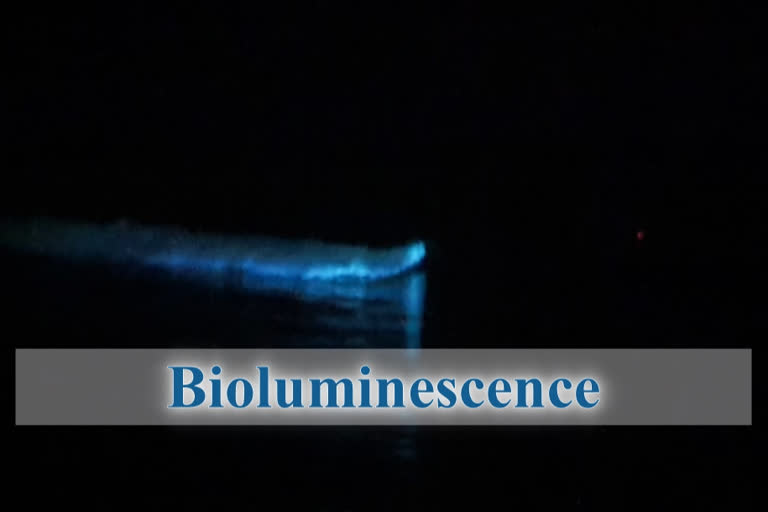Mangaluru: College of Fisheries at Mangaluru which carried out a study after the coastal waters in some beaches of Karnataka started witnessing the phenomenon called bioluminescence in the last few days. The researchers' team found the presence of Noctiluca scintillans, the plankton is the cause for bioluminescence in the coastal waters.
According to college authorities, during last few days College of Fisheries, Mangalore has been receiving reports, photographs indicating bioluminescence in the coastal waters along Malpe and adjacent areas.
Based on the report, the scientists from the College comprising of Dr M T Lakshmipathi, Dr T S Annappaswamy, Dr Rajesh D. P, Chandhan and Harshath visited the sites for observation and collected water samples along the coastal stretches of Pudukere, Sashihittalu and Surthkal beaches on Saturday.
Collection of water and plankton samples at Padukere beach, Malpe The water sample for plankton analysis has been collected using 60 micron mesh size. The water samples are analysed for the plankton composition and bacterial composition.
The plankton analysis has been carried out using the microscopic method and its found that the major plankton composition consists of Noctiluca scintillans. This plankton is the cause of bioluminescence in the coastal waters.
Bioluminescence occurs widely in marine vertebrates and invertebrates, as well as in some fungi, microorganisms, including some bio-luminescent bacteria. This phenomenon which is natural has been noticed since the last two days at Padukere, Sashihithlu and NITK Suratkal beaches, and earlier at Tannirubavi, Panambur, Ullal and Someshwara beaches.
Dr A Senthil Vel, Dean of College of Fisheries, Mangalore said that the scientists from the College are continuously monitoring the waters. The bacterial analysis is being carried out and the results will be analysed by November 24. The results will indicate if there are any other bioluminescent bacteria / other microorganisms as well. "We need to track the bloom and find out if there are any fish kill or obnoxious smell from the area,", Vel said.
So far, no such fish kill has been reported in these stretches.
Changing phenomena of the Western Coast
It is important to note that western coastal stretches of India of late have been experiencing a certain phenomenon.
During the month of December 2019 to February 2020, there was an invasion of Kargil fish, which was found in huge quantities. The college has reported this incident also. Now along the Goa coast, there is the presence of a large number of jellyfish and tourist have been warned as their stings are poisonous. And now the bioluminescence plankton blooms along the Karnataka coast.
It will be difficult to pinpoint the sudden bloom of the Noctiluca species. But based on the preliminary data it appears that the water temperature are high, that is around 32 0 C, while the atmospheric temperature was around 30 0 C at 6.00 pm on November 21, Saturday. The luminous of the plankton was high at 7.30 pm.
High temperature, high quantity of organic material such as sewage and effluents and increased turbulence/wave action of the water could be the cause for this sudden bloom. Apart from human causes, the adverse impact of global warming leading to increased seawater temperature could be playing a major role in such a phenomenon.
What is bioluminescence?
Bioluminescence is light emitted by living organisms or algae through chemical reactions in their bodies. It could also be the ghostly glow of bacteria on decaying organic matter or in the sediment/sand. The glow or sparkle in the sea is due to the bloom of dinoflagellates scientifically called Noctiluca scintillans and commonly known as the sea sparkle. This plankton is a free-living, marine-dwelling species that exhibits bioluminescence when disturbed.
What causes bioluminescence?
Noctiluca, genus of marine dinoflagellate in the family Noctilucaceae, consisting of a single species, Noctiluca scintillans, one of the most commonly occurring bioluminescent organisms in coastal regions of the world. The scintillating effect of Noctiluca’s bioluminescence, which is most conspicuous at night during a bloom, was historically a mysterious phenomenon, frequently contributing to what was called “burning of the sea” or “sea sparkle” by sailors and coastal inhabitants. Today, such blooms, which forms a thick scum across the sea surface, visibly red or pink in daylight, are known to be hazardous to fish and certain other marine species.
Noctiluca scintillans (Sea sparkle) as seen under the microscope Noctiluca, which is a large (about 1–2 mm [0.04–0.08 inch] in diameter), spherical, gelatinous single-celled organism. N. scintillan is a dinoflagellate (zooplankton) known to feed on other phytoplankton. The luminescence in this plankton is caused due to the thousands of granules that contain luciferin and luciferase, the substances that carry out the bioluminescence reaction.
Read: Indian Navy to Host Exercise SIMBEX-20 in Andaman Sea
